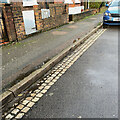1
Battlefield Road
A road of large mainly detached houses, developed in the 1920s and 1930s. The name commemorates the Second Battle of St Albans in 1461, fought on nearby Bernards Heath.
Image: © Ian Capper
Taken: 24 Jul 2020
0.01 miles
2
Warwick Road
Housing in the mainly late 19th/early 20th Century development of "Sandridge New Town", an area of land between Sandpit Lane and Sandridge Road, originally outside the boundaries of St Albans and in the parish of Sandridge, prior to the extension of the municipal area in 1879, just south of where Boundary Road was laid out. Warwick Road was one of the later roads to be developed, and even then only the western side (just visible on the left of the photo). The eastern side (seen here) originally marked the end of the back gardens of houses in Battlefield Road, only later being developed after the c.1980s with successive building up to the early 2000s.
Image: © Ian Capper
Taken: 11 Sep 2020
0.03 miles
3
Warwick Road
Housing in the mainly late 19th/early 20th Century development of "Sandridge New Town", an area of land between Sandpit Lane and Sandridge Road, originally outside the boundaries of St Albans and in the parish of Sandridge, prior to the extension of the municipal area in 1879, just south of where Boundary Road was laid out.
Warwick Road was one of the later roads to be developed, and even then only the western side (seen here). The eastern side was not developed until the 1980s onwards (see
Image).
Image: © Ian Capper
Taken: 5 Jul 2021
0.04 miles
4
Boundary Road
Housing in the mainly late 19th/early 20th Century development of "Sandridge New Town", an area of land between Sandpit Lane and Sandridge Road, originally outside the boundaries of St Albans and in the parish of Sandridge, prior to the extension of the municipal area in 1879, just south of where Boundary Road was laid out.
Image: © Ian Capper
Taken: 11 Sep 2020
0.06 miles
5
Walton Street
Housing in the mainly late 19th/early 20th Century development of "Sandridge New Town", an area of land between Sandpit Lane and Sandridge Road, originally outside the boundaries of St Albans and in the parish of Sandridge, prior to the extension of the municipal area in 1879, just south of where Boundary Road (in the background) was laid out. Maps suggest that Walton Street was one of the later roads to be developed, with the houses on this side being on what was previously part of the land surrounding St Saviour's Church.
Image: © Ian Capper
Taken: 11 Sep 2020
0.08 miles
6
Upper Heath Road
Housing in the mainly late 19th/early 20th Century development of "Sandridge New Town", an area of land between Sandpit Lane and Sandridge Road, originally outside the boundaries of St Albans and in the parish of Sandridge, prior to the extension of the municipal area in 1879, just south of where Boundary Road was laid out. Upper Heath Road is the extension of Heath Road north of Boundary Road.
Image: © Ian Capper
Taken: 11 Sep 2020
0.08 miles
7
Boundary Road
Housing in the mainly late 19th/early 20th Century development of "Sandridge New Town", an area of land between Sandpit Lane and Sandridge Road, originally outside the boundaries of St Albans and in the parish of Sandridge, prior to the extension of the municipal area in 1879, just south of where Boundary Road was laid out.
Image: © Ian Capper
Taken: 11 Sep 2020
0.08 miles
8
Walton Street
Housing in the mainly late 19th/early 20th Century development of "Sandridge New Town", an area of land between Sandpit Lane and Sandridge Road, originally outside the boundaries of St Albans and in the parish of Sandridge, prior to the extension of the municipal area in 1879, just south of where Boundary Road (in the foreground) was laid out. Maps suggest that Walton Street was one of the later roads to be developed, with the houses on this side being on what was previously part of the land surrounding St Saviour's Church, the top of whose spire can be seen in the background.
Image: © Ian Capper
Taken: 11 Sep 2020
0.08 miles
9
Lancaster Road
One of a pair of roads (the other being the parallel Battlefield Road) developed in the 1920s/30s with names commemorating the second Battle of St Albans which was fought in 1461 on nearby Bernards Heath.
Image: © Ian Capper
Taken: 1 May 2020
0.08 miles
10
Channel, Upper Heath Road, St Albans
The three rows of stone blocks or setts forming the channel make a pleasing contrast with the tarmac: warm cream against purplish dark grey; coarse texture against fine-grained. The setts are the colour of Clunch but it seems unlikely that a form of chalk would be able to withstand wetting and the passage of vehicles.
Page 23 of the glorious Hertfordshire Strategic Stone Study from Historic England https://www2.bgs.ac.uk/mineralsuk/download/EHCountyAtlases/Hertfordshire_Building_Stone_Atlas.pdf illustrates a similar construction in St Michael's Street, St Albans. Upper Heath Road is unlikely to be different. The kerb (which could be mistaken for concrete) is identified as Sarsen Stone, probably from Buckinghamshire, and the setts as Granodiorite, an igneous rock well able to withstand wear and tear, possibly from the Newry area of County Armagh; 'Newry Granite', according to Wikipedia.
Image: © Robin Stott
Taken: 15 Nov 2022
0.08 miles











